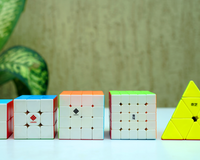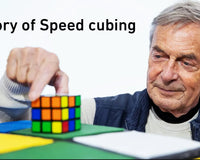What Is the Pyraminx? (Triangle Rubik’s Cube Explained)
You are aware that a Pyraminx has its own charm and is more than just a twisting puzzle. People like it because it looks like a cool pyramid, turns with nice clicks, and is simple to use, especially for beginners and children. However, what causes it to function as it does? Let's explore it.
The Geometry That Makes It Unique

It's a little misleading to refer to the Pyraminx as the "triangle Rubik's Cube." The Pyraminx is a tetrahedral puzzle, whereas the Rubik's Cube is a 3x3x3 cube. It resembles a pyramid and has four sides.
One of the most basic three-dimensional structures, the tetrahedron, serves as the foundation for the main portion. Unlike a 3x3, the Pyraminx does not have a complex core. Rather, it has a ball-and-socket design with a rotating tips. It feels very different when you turn it; it's snappier and softer, and when everything locks into place, there's a satisfying click.
The puzzle has 3 tips, 3 edges, and 3 centers on each face. Interestingly, the tips don’t affect the solve much; they’re more like decorations that you align at the end. The real challenge comes from solving the edge pieces, which are the main parts that scramble.
Why It’s Faster to Solve?

One of the coolest things about the Pyraminx is how quickly it can be solved. For many people, it’s the first WCA puzzle they can solve in under 10 seconds, sometimes even under 5!
The reason? Low move count. While a 3x3 average solve takes around 55 moves, the Pyraminx can be solved in just 9-12 moves for a typical scramble. That’s a huge difference. Plus, since the tips are easy to turn and don’t impact the scramble much, you can align them quickly before or after the main solve.
The Algorithms Behind It
Even though it’s an easier puzzle, the Pyraminx still has its fair share of algorithms. The most popular beginner method is the layer-by-layer approach: First, solve one face and its adjacent edges.
L4E (Last 4 Edges) and Keyhole are two more advanced approaches that skip steps and go straight to finishing all four edges at once. These advanced methods help speedcubers reach those crazy 2-3 second solves by cutting down on the number of moves they have to make.
Finger Tricks and Turning Style

If you’ve watched top Pyraminx solvers, you’ll notice they turn it completely differently from a 3x3. The small size and tip design mean that wrist moves don’t work as well. Instead, it’s all about finger tricks. Push the layers with your fingers, flick the tips, and use both hands to control the puzzle smoothly.
This is how cubers hit sub-5-second times!
Why is it a Fan Favorite?
The Pyraminx is just plain fun, aside from its satisfying feel and speed. A solution is quick and satisfying, and it's not as intimidating as a large NxN cube. In addition, it has been around since the early 1970s, making it one of the oldest twisty puzzles after the Rubik's Cube!
It's definitely worth getting if you haven't tried one before. If you already have one, it might be time to experiment with more advanced methods and see how quickly you can go!
🛒 Which Pyraminx Should You Buy?
Best Pyraminx Cubes for Beginners:
- Drift Pyraminx – Great budget option with smooth turns
- GAN Pyraminx – Premium magnetic feel, used by pros
- Drift Pyraminx M – Best value speedcube with snappy turns
Explore our full Pyraminx Collection →
📈 Most Searched FAQs About Pyraminx
🔹 Is the Pyraminx hard to solve?
Not at all! Most beginners can learn it in under 30 minutes.
🔹 How many combinations does a Pyraminx have?
Around 933,120, compared to 43 quintillion for a 3x3 cube.
🔹 What’s the world record for Pyraminx?
As of now, 0.91 seconds—yes, under 1 second!






























